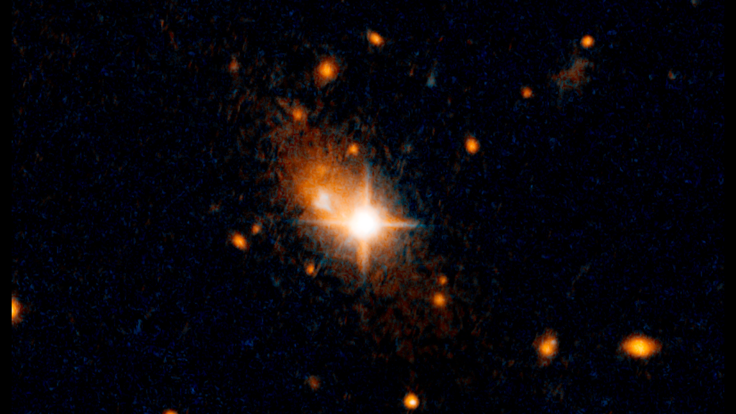Supermassive Black Hole Kicked Out Of Galactic Core By Gravitational Waves

If really big numbers don’t make sense to you, this story may leave you confused. But when supermassive black holes are involved, especially one that is 8 billion light-years away and weighs more than 1 billion suns, large numbers are inevitable.
In the largest discovery of its kind yet, astronomers using NASA’s Hubble Space Telescope have found a supermassive black hole — powering a quasar called 3C 186, in the center of galaxy about 8 billion light-years away in a galaxy cluster — which has been dislodged from its position at the center of the aforesaid galaxy. According to estimates by researchers, the energy required to jettison the black hole from its position was equivalent to 100 million supernovas exploding simultaneously, and they theorize that this massive force was produced by gravitational waves, caused by the merger of two large black holes at the center of the galaxy.
Read: How Did Supermassive Black Holes Form In The Very Early Universe?
The two large black holes whose merger evicted the resident supermassive black hole likely turned up in the vicinity as a consequence of the merger between their own host galaxies, and this latter phenomenon was what astronomers were initially studying, when they stumbled upon the eviction of 3C 186.
A statement Thursday from NASA explains the theory put forth by the team to explain the merger.
“Two galaxies merge, and their black holes settle into the center of the newly formed elliptical galaxy. As the black holes whirl around each other, gravity waves are flung out like water from a lawn sprinkler. The hefty objects move closer to each other over time as they radiate away gravitational energy. If the two black holes do not have the same mass and rotation rate, they emit gravitational waves more strongly along one direction. When the two black holes collide, they stop producing gravitational waves. The newly merged black hole then recoils in the opposite direction of the strongest gravitational waves and shoots off like a rocket.”
Marco Chiaberge of the Space Telescope Science Institute (STScI) and Johns Hopkins University, in Baltimore, Maryland, who leads a team publishing a paper on the subject in the March 30 issue of the journal Astronomy & Astrophysics, said in the statement: “I was anticipating seeing a lot of merging galaxies, and I was expecting to see messy host galaxies around the quasars, but I wasn’t really expecting to see a quasar that was clearly offset from the core of a regularly shaped galaxy. Black holes reside in the center of galaxies, so it's unusual to see a quasar not in the center.”
According to the team’s calculations, the black hole has already traveled over 35,000 light-years from its galactic center. For context, it is more than the distance between the sun and the center of the Milky Way. The speed at which the supermassive black hole is traveling, over 4.7 million miles an hour, will take it to the moon from Earth in about three minutes. But given the size of its galaxy, it will take the black hole 20 million years to escape the galaxy altogether, after which it will roam through the universe for perpetuity.
The research team hopes to use Hubble again, in combination with other facilities like the Atacama Large Millimeter/submillimeter Array (ALMA), to measure the speed of the black hole and its gas disk more accurately, which will provide better insight into the properties of this unusual object.
© Copyright IBTimes 2024. All rights reserved.





















